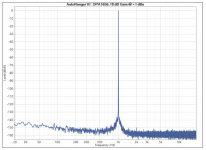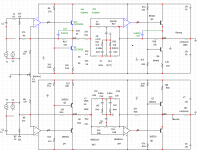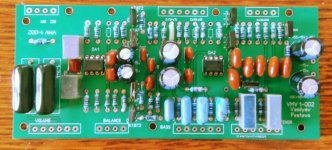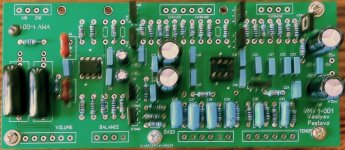Noisy?
Maybe perhaps you've used some "off brand" versions, but Texas Instruments TL072CP's that I've used are dead silent, and I've used them in various preamp circuits.
No noise, no hiss... silence.
There are lots of better options, though. Why limit ourselves to ancient op-amps? Time moves on. The OP asked for the best. There are dozens of better options now.
OPA1656 and OPA1642 are just two that are far higher performance and reasonably priced.
By powering the NE5532 op amp with a repeater with a current source, you get an excellent base for a preamp, tone control, or just a buffer amplifier.
There are lots of better options, though. Why limit ourselves to ancient op-amps? Time moves on. The OP asked for the best. There are dozens of better options now.
OPA1656 and OPA1642 are just two that are far higher performance and reasonably priced.
Nothing beats an OPA1656 these days.
Jan
Attachments
I´d LOVE to know what are OP design requirements first 🙂
Just sayin´
Indeed, it does get a bit annoying, someone comes freshly on here with vague questions.
It's like....
I have a car, it's got tires. (no make/model/nothing explained)
What are better tires for it.?
I would try to steer the OP away from modern very high speed opamps. It is harder to tame these devices and the OP will end up with problems they never knew existed.
I bought a cheap TPA6120A2 board off ebay that oscillates at ~100MHz. Many beginners would just write it off as a crap IC, but it's actually the implementation that is at fault. A slower older opamp could give a superior result, and to that end I feel the '5534 or '5532 hits the spot.
I bought a cheap TPA6120A2 board off ebay that oscillates at ~100MHz. Many beginners would just write it off as a crap IC, but it's actually the implementation that is at fault. A slower older opamp could give a superior result, and to that end I feel the '5534 or '5532 hits the spot.
True, but some of the options put forth in this thread are not exactly 300 MHz DSL line drivers like TPA6120 (THS6012). OPA1642 or OPA2134 are relatively tame.
performances and... cases. DIP are not trendyI´d LOVE to know what are OP design requirements first 🙂

TPA6120A2 is a beefy 300MHz CFA and most of the boards you can buy on eBay just disrespect pretty much all recommendations for proper layout of this part (especially the part about stray capacitance at the inverting input). However I don't think one should stay away from all VFAs that are faster than NE5532 because of that. I'd instead say that the OP should stay away from using SMD-OpAmps that are significantly faster than for example NE5532 in combination with DIP adapter boards and sockets.
As JMFahey said, some design requirements would be needed to make proper recommendations. A preliminary block diagram would also be helpful 🙂
Edit: I think Jan mentioned somewhere he had no trouble with OPA1656 on adapter boards, maybe he can confirm this again and maybe even say in which configuration(s).
As JMFahey said, some design requirements would be needed to make proper recommendations. A preliminary block diagram would also be helpful 🙂
Edit: I think Jan mentioned somewhere he had no trouble with OPA1656 on adapter boards, maybe he can confirm this again and maybe even say in which configuration(s).
Last edited:
The TL07x's have always been my go to opamp since the late 70's and the NE5532's are hard to beat as well, even though there are nicer devices these days, I just picked up a Bunch of ST TL074's for like $.25 a piece, can't go wrong there.
They sound just as good as good can get, if you want better your gonna pay for it.
JRC, no sir I Just Don't like them, there are a few of them that are alright , but I try to stay as far away from them as I can get !!
I won't buy any new JRC's for my projects and i have only a few commercial device that use them, generally I can tell they are being used just by listening to a device that has them in it.
I once had a Fostex 454 mixer loaded full of JRC's and I swapped them all out with TL08x' and NE5532's and the difference was huge !!!
It gave my brand new Mackie 32-8 a run for it's money back when it was new in 1994 that IIRC is loaded with 4562's I believe.
I do have quite a few of the LME and OPA series from NS/TI before they ditched the overture stuff, I haven't even used them yet, saving them for my final build I guess.
Lately I have been enjoying the devices that LT has to offer these days, currently working with the LT1057 series, anything from LT is Excellent IMHO !!
Most of them are Superfast and Superquiet, many have a higher power supply voltage tolerance as well !! 😉
Analog Devices, I have some of those too but have not used any of them yet.....Pricey !! 😉
FWIW
jer 🙂
They sound just as good as good can get, if you want better your gonna pay for it.
JRC, no sir I Just Don't like them, there are a few of them that are alright , but I try to stay as far away from them as I can get !!
I won't buy any new JRC's for my projects and i have only a few commercial device that use them, generally I can tell they are being used just by listening to a device that has them in it.
I once had a Fostex 454 mixer loaded full of JRC's and I swapped them all out with TL08x' and NE5532's and the difference was huge !!!
It gave my brand new Mackie 32-8 a run for it's money back when it was new in 1994 that IIRC is loaded with 4562's I believe.
I do have quite a few of the LME and OPA series from NS/TI before they ditched the overture stuff, I haven't even used them yet, saving them for my final build I guess.
Lately I have been enjoying the devices that LT has to offer these days, currently working with the LT1057 series, anything from LT is Excellent IMHO !!
Most of them are Superfast and Superquiet, many have a higher power supply voltage tolerance as well !! 😉
Analog Devices, I have some of those too but have not used any of them yet.....Pricey !! 😉
FWIW
jer 🙂
Last edited:
Preamp with tone control .RT can be disabled .Volume control switch or cookie, or ladder type
Attachments
Last edited:
Not sure if anyone noticed but just recently TI has introduced an upgraded TL07xH series of parts with improved specs
Not sure if anyone noticed but just recently TI has introduced an upgraded TL07xH series of parts with improved specs
https://www.ti.com/lit/ds/symlink/tl072.pdf?ts=1609434014036&ref_url=https%253A%252F%252Fwww.ti.com%252Fsitesearch%252Fdocs%252Funiversalsearch.tsp%253FsearchTerm%253DTL072h
Not sure I would call that an upgrade across the board. While input offset spec is substantially tighter, input capacitance much reduced, distortion performance improved, idle current consumption lowered and supply limits upperd to +/-20 V, input noise is quite a bit higher (and the TL07x didn't set any records to begin with). The high 1/f corner leads me to believe that H = HVCMOS perhaps? Seems to be a reimagination of the part based on current technology.Not sure if anyone noticed but just recently TI has introduced an upgraded TL07xH series of parts with improved specs
I guess it'll have its uses, but those would seem to be more in guitar pedals than hi-fi at this point. Maybe for a DC servo?
Not sure I would call that an upgrade across the board.
I guess it'll have its uses, but those would seem to be more in guitar pedals than hi-fi at this point. Maybe for a DC servo?
I think that's a bit picky.
I'm certainly a "picky' type myself, and using the Texas Instruments TL072M's in some projects I find them quite capable of "hifi" operation.
As I've mention previously, they are dead silent with no signal, and performance is outstanding.
Not really 😀There are lots of better options, though. Why limit ourselves to ancient op-amps? Time moves on. The OP asked for the best. There are dozens of better options now.
He actually called for "better than 4558" 😉 and in that case, TL07x is a good answer: cheap, ´plentiful, specially a non written standard used by most "everybody", well known, etc.
Yes, there are "even better" ones, no doubt, but we *might* bring unneeded trouble.
The very question points to a beginner, (we all were once 🙂 ), personally I prefer to offer the most tried and generic answer possible.
EDIT: on the question of price.
Yes, $2.50 for a cutting edge Op Amp is "nothing" within some project bill of components which can run, say, $50/100/200
For a new experimenter, $5 will bring TEN TL072 , enough to experiment A LOT , you can build new stuff without cannibalizing old projects, damage one or two because of wrong connections, whatever.
Same TWO lightspeed ones will be treated with kid gloves and sort of slow you.
Trust me, I remember my early experimenter years (over 50 years ago by now) when components were precious, I recycled old TVs and "Audio" equipment, even bought surplus IBM computer cards by the kilo and pulled components free by the dreaded "burn and slap" method.
Some greybeards might remember it.
This is the modern "safe" way of course, way back then I used a propane torch and slapped boardson a table covered with newspaper.
How to salvage parts from old PCBs, even from motherboards! - YouTube
Last edited:
Not really 😀
He actually called for "better than 4558" 😉 and in that case, TL07x is a good answer: cheap, ´plentiful, specially a non written standard usedby most "everybody", well known, etc.
Yes, there are "even better" ones, no doubt, but we *might* bring unneeded trouble.
The very question points to a beginner, (we all were once 🙂 ), personally I prefer to offer the most tried and generic answer possible.
I completely agree with you, which is why I suggested easy to use substitutes.
The OP did actually ask for the best, though.
Hi guys I'm new here, I just wanted to ask your opinion about what opamp IC is best for designing a preamp?
Well, yes, but I usually try to answer in context. 🙂
I took "best" as in "best for me" 🙂 , not "absolute best".
Maybe reading too much in the question? 🙁
Always trying to be as helpful as possible, of course.
I took "best" as in "best for me" 🙂 , not "absolute best".
Maybe reading too much in the question? 🙁
Always trying to be as helpful as possible, of course.
You can parallel TL072, 2 op-amps or even 4 op-amps are still cheap. Input voltage noise is reduce and output current capability is increase so you can use low value of resistors feedback.
In years past the AD711 / AD712 / AD713 were great upgrades (if a bit costly) for existing equipment with TL07x parts. Now you'd be nuts to spend $14 on what is (essentially) a souped-up TL074. I still have a lot of AD713 that I got for practically nothing, and they're a really nice part to work with. They're very stable and they offer respectable noise and distortion performance. IMO, they're too expensive but great parts to use.
IMO, the TL07x series is fantastic for what they cost, but their distortion performance is rather mediocre. I still use them quite often, since I have a whole bag of TL074s and very often they're good enough.
As Jan noted, pretty much nothing can touch the OPA1656, and the price is very reasonable. Some of the lowest distortion of any op-amp on the market, and in most cases, some of the best noise performance. It also has some of the best load-driving capabilities (I believe it is rated for up to 100 mA).
The OPA1642 is also a pretty nice little chip, and it's slightly cheaper than the OPA1656.
Yes it's only available in SMD packages, but SOIC-8 is no harder to solder than a DIP package. Desoldering SMD (especially if you have a hot air station, which have gotten pretty cheap these days) is way easier than desoldering plated through-holes.
The LM4562 is still a killer deal for what it costs. Easy to use with fantastic performance.
I have seen some people use ridiculously fast video op-amps for audio applications. IMO, there's point. These op-amps (thinks like the AD828) exist for a purpose, and it isn't audio. They're very useful in instrumentation applications, or when you need sub-microsecond response times from a protection circuit. All they do in an audio circuit is cause instability, and most of them don't have the best distortion performance.
In general, Texas Instruments has been leading when it comes to audio op-amps. They have some of the best performing parts on the market, and their prices are reasonable. I love Analog Devices parts, but where they shine is when cost isn't a concern and you need something nobody else offers. This usually isn't in the audio world, though their SSM2019 is a great little chip for mic preamps.
It wasn't all that long ago that beating the performance of the 5532 / 5534 required spending 10 times as much, but at this point there are chips for only a couple dollars that eat 5532s for breakfast. The 5532 also has an annoying quirk where it will self-destruct if it loses one of the two voltage rails. That sucks pretty hard in mixing console applications, where losing a power rail can blow up a few hundred op-amps in a single go.
IMO, the TL07x series is fantastic for what they cost, but their distortion performance is rather mediocre. I still use them quite often, since I have a whole bag of TL074s and very often they're good enough.
As Jan noted, pretty much nothing can touch the OPA1656, and the price is very reasonable. Some of the lowest distortion of any op-amp on the market, and in most cases, some of the best noise performance. It also has some of the best load-driving capabilities (I believe it is rated for up to 100 mA).
The OPA1642 is also a pretty nice little chip, and it's slightly cheaper than the OPA1656.
Yes it's only available in SMD packages, but SOIC-8 is no harder to solder than a DIP package. Desoldering SMD (especially if you have a hot air station, which have gotten pretty cheap these days) is way easier than desoldering plated through-holes.
The LM4562 is still a killer deal for what it costs. Easy to use with fantastic performance.
I have seen some people use ridiculously fast video op-amps for audio applications. IMO, there's point. These op-amps (thinks like the AD828) exist for a purpose, and it isn't audio. They're very useful in instrumentation applications, or when you need sub-microsecond response times from a protection circuit. All they do in an audio circuit is cause instability, and most of them don't have the best distortion performance.
In general, Texas Instruments has been leading when it comes to audio op-amps. They have some of the best performing parts on the market, and their prices are reasonable. I love Analog Devices parts, but where they shine is when cost isn't a concern and you need something nobody else offers. This usually isn't in the audio world, though their SSM2019 is a great little chip for mic preamps.
It wasn't all that long ago that beating the performance of the 5532 / 5534 required spending 10 times as much, but at this point there are chips for only a couple dollars that eat 5532s for breakfast. The 5532 also has an annoying quirk where it will self-destruct if it loses one of the two voltage rails. That sucks pretty hard in mixing console applications, where losing a power rail can blow up a few hundred op-amps in a single go.
- Home
- Source & Line
- Analog Line Level
- Audio IC Preamp



